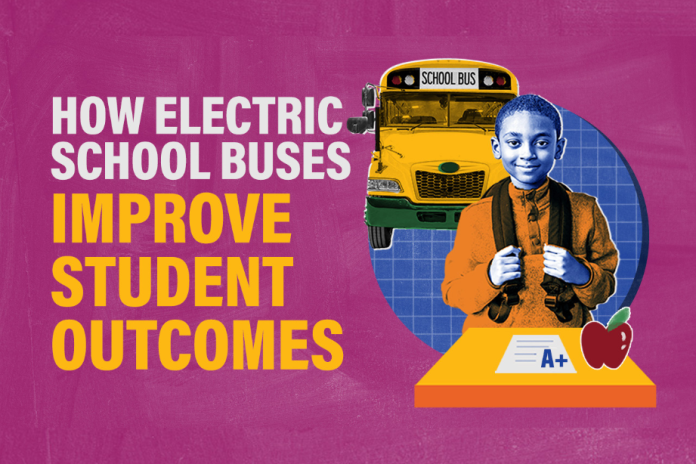Students Need Access to a Clean Ride to School
How can you help students access clean rides to school?

More than 90% of U.S. school buses are diesel-powered buses that release toxic pollutants linked to serious physical health issues as well as cognitive impacts. Of course, these pollutants affect drivers and adults near the buses, but children can be particularly susceptible to the impacts.
Even among students, these risks are not felt equally.
Black students, students with disabilities and low-income students rely on school buses more than their white, able-bodied and higher-income peers. Riding on older diesel-burning buses, which emit more pollutants, can even be linked to increased absences.
Many of these students not only experience toxic fumes on the bus but are also more likely to live in communities with high levels of air pollution. Exposure to these pollutants early in life is linked to reduced reading and math scores at the start of school.
How Electric School Buses Can Help
Because electric school buses have no tailpipe emissions, switching to electric school buses reduces exposure to the unsafe air pollutants diesel-burning school buses emit from their tailpipes. Replacing all of the oldest diesel-burning school buses in the nation could amount to 1.3 million fewer daily absences annually.
While the transition to electric school buses benefits all students, an equitable transition will prioritize the needs and the voices of the students who depend on the bus, who spend the most time on the bus and who experience the most air pollution in their lives outside of school.
How You Can Help
Students, parents, drivers and community members: Ask your district about electrification.
- Use this pitch deck to talk to your school board, superintendent or transportation director about electrification.
- Visit our data dashboard to learn about your district's fleet and start a conversation about electrification, especially if your buses are older than 13 years.
School districts: When you begin electrifying, consider prioritizing routes based on race, income or air pollution and investing in accessible electric school buses so that students with disabilities receive the health benefits of a clean ride.
- Go to our Electric School Bus U.S. Buyer's Guide to find accessible bus options.
- Use tools like: EPA Air Quality Index, Census Data, or University of Richmond’s Redlining Tool to help with route selection.
- Hold meetings to discuss your electrification plans with bus drivers and bus riders.
Policymakers: As you develop policies that impact school transportation, prioritize the students that spend the most time on buses and bear the greatest overall air pollution burden.
- Direct funding to communities that have been historically disadvantaged. In New Jersey at least half of their electric school bus grant funding must go to “low-income, urban, or environmental justice communities.”
- Prioritize community outreach. Strong support from grassroots organizations like Green Latinos helped push Colorado to include a school bus program in their 2022 Air Quality Improvement Investments bill.
Where Can You Learn More
- The Alliance for Electric School Buses
- Mothers Out Front
- Moms Clean Air Force
- Equity Framework to Guide the Electric School Bus Initiative– WRI’s Electric School Bus Initiative
- How Students Can Take Action – WRI’s Electric School Bus Initiative
- How we identified “Priority Outreach Districts”– WRI’s Electric School Bus Initiative
- Leading the Charge: Advocacy Organizations At the Forefront of the ESB Transition – WRI’s Electric School Bus Initiative